Burlington Coat Factory Bundle
How Does Burlington Coat Factory Thrive in a Competitive Market?
Discover the secrets behind Burlington Coat Factory's enduring success in the off-price retail sector. From its humble beginnings as a coat retailer to its evolution into a major department store, Burlington has consistently offered compelling value to its customers. This deep dive explores the Burlington Coat Factory SWOT Analysis, sales and marketing strategies, and strategic initiatives that have fueled its growth.
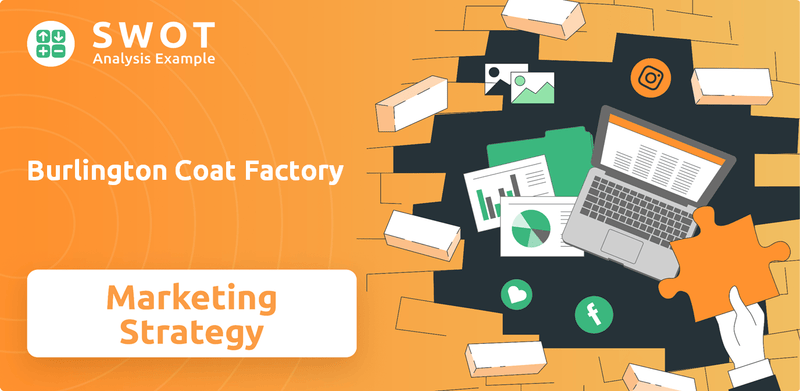
Understanding Burlington's approach provides valuable insights into its Burlington marketing strategy and how it captures its Burlington Coat Factory target market. We'll examine its Burlington Coat Factory business model, dissecting its Burlington Coat Factory sales strategy, and examining how it leverages Burlington Coat Factory pricing strategy to maintain its competitive edge against rivals. This analysis will also touch upon its Burlington Coat Factory competitive analysis and expansion plans.
How Does Burlington Coat Factory Reach Its Customers?
The core of the Burlington Coat Factory sales strategy revolves around its extensive network of physical retail stores. As of the end of fiscal year 2024, the company operated a substantial 1,108 stores across a wide geographical area, including 46 states, Washington D.C., and Puerto Rico. This robust brick-and-mortar presence is central to its business model, offering customers a 'treasure hunt' shopping experience.
Burlington's expansion plans are aggressive, with approximately 100 net new store openings projected for fiscal year 2025. The long-term goal is to operate 2,000 stores, with many new locations being smaller, around 25,000 square feet. These strategically located stores often occupy spaces previously held by bankrupt retailers, a successful approach for the company.
While primarily focused on in-store sales, Burlington is also evolving its Burlington marketing strategy to include a growing digital presence. This shift indicates a move toward omnichannel integration, even though the primary sales driver remains the in-store experience. The company's efficient inventory management and operational strategies allow it to offer significant discounts, up to 60-70% off department store prices, which is a key competitive advantage.
Burlington's primary sales channel is its network of physical stores. The company's focus on in-store experience is a key component of its value proposition. This strategy allows for a 'treasure hunt' shopping experience, driving customer engagement and loyalty.
Burlington is expanding its digital presence to enhance brand awareness. The company uses targeted online marketing campaigns and a growing social media presence. This supports the in-store experience and increases customer reach.
The company plans to open approximately 100 net new stores in fiscal year 2025. Burlington aims to operate 2,000 stores long-term. Many new stores are strategically located in busy strip malls, often backfilling spaces.
Burlington offers significant discounts, up to 60-70% off department store prices. This pricing strategy helps drive sales and attract customers. The company's efficient inventory management contributes to this advantage.
Burlington's sales channels are primarily focused on physical retail, with increasing emphasis on digital marketing. The company's expansion plans and competitive pricing are crucial components of its growth strategy. To understand more about the company's growth, you can read about the Growth Strategy of Burlington Coat Factory.
- Extensive network of physical stores across multiple states.
- Strategic expansion with new store openings planned for fiscal year 2025.
- Targeted online marketing campaigns and social media presence.
- Competitive pricing strategy with significant discounts.
Burlington Coat Factory SWOT Analysis
- Complete SWOT Breakdown
- Fully Customizable
- Editable in Excel & Word
- Professional Formatting
- Investor-Ready Format
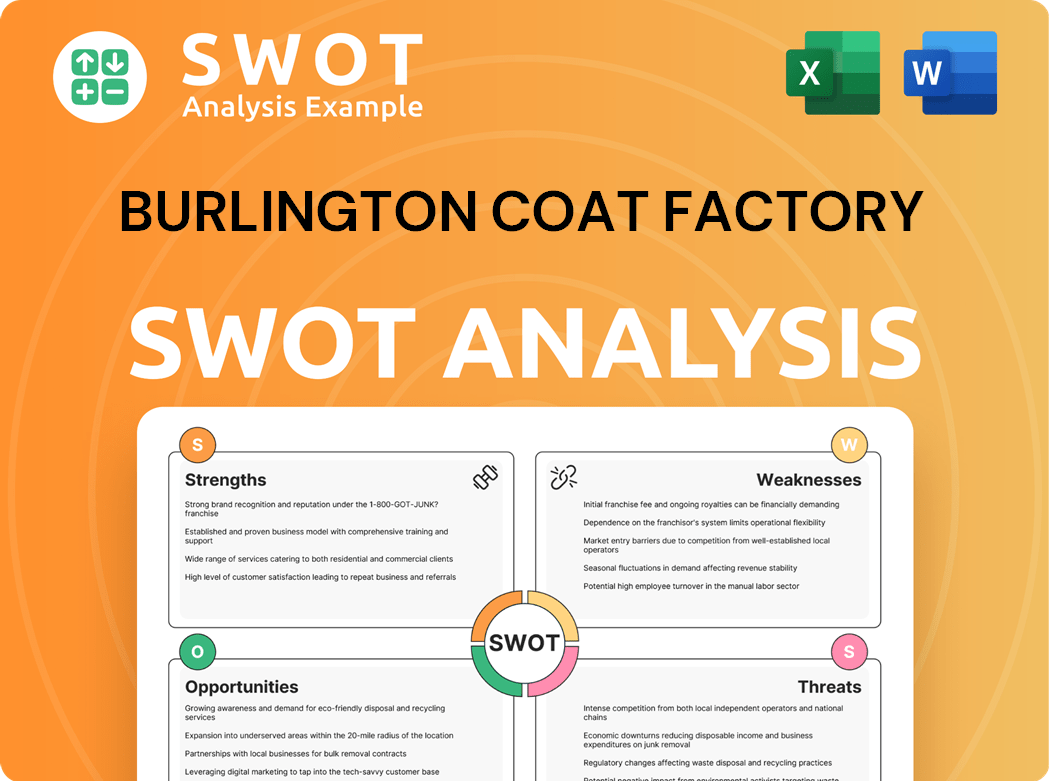
What Marketing Tactics Does Burlington Coat Factory Use?
The marketing tactics employed by Burlington Stores are designed to boost sales and build brand awareness, primarily by emphasizing its value proposition. The core strategy involves attracting value-conscious shoppers by consistently offering brand-name and designer merchandise at substantial discounts. This approach includes creating a 'treasure hunt' shopping experience, encouraging frequent store visits to discover new arrivals and deals.
Burlington's marketing efforts also involve digital campaigns and a growing social media presence to reach a wider audience and drive traffic to its physical locations. The company's investor relations communications suggest the use of its website and social media channels to communicate important information, including new marketing campaigns. This integrated approach aims to enhance brand awareness and customer engagement.
Television advertising has been a part of Burlington's marketing mix, with recent TV spots promoting coat events and holiday deals in late 2024. These commercials often highlight discounted pricing, aligning with the company's core value proposition. The company's marketing mix supports its store expansion and the 'Burlington 2.0' initiative, which aims to improve marketing, merchandising, and supply chain efficiencies, driving long-term value creation.
Burlington's Burlington Coat Factory sales strategy focuses on providing significant discounts on brand-name and designer merchandise. This value-driven approach is central to attracting and retaining customers. This strategy is crucial for the company's Burlington marketing strategy.
Digital tactics include online marketing campaigns and social media engagement to reach a broader audience. While specific details on content marketing, SEO, and influencer partnerships for 2024-2025 are not extensively publicized, the company's general approach to digital expansion aims to enhance brand awareness and customer engagement. The company's digital efforts are part of its overall Burlington Coat Factory business model.
Television advertising remains a component of Burlington's marketing mix, with recent TV spots promoting coat events and holiday deals. These commercials emphasize discounted pricing. This advertising supports the company's value proposition and drives sales during key shopping seasons.
Burlington strategically segments its customers into lower-income groups and those with moderately higher incomes seeking affordable options, tailoring its merchandising and marketing to meet diverse demands. This segmentation is a key part of their Burlington Coat Factory target market approach.
The company's marketing mix supports its strategic store expansion and the 'Burlington 2.0' initiative, which aims to improve marketing, merchandising, and supply chain efficiencies. This suggests an ongoing effort to optimize marketing spend and strategies to drive long-term value creation.
Burlington utilizes its website and social media channels to communicate important information, including new marketing campaigns, to investors and the public. This transparent approach helps maintain investor relations and build brand trust. For more details, see Growth Strategy of Burlington Coat Factory.
Burlington's marketing tactics are designed to build awareness and drive sales. These tactics include a focus on value, digital marketing, and traditional advertising. The company continuously adapts its strategies to meet evolving consumer demands and market trends. The company's approach also includes elements of Burlington Coat Factory competitive analysis and Burlington Coat Factory pricing strategy.
- Value Proposition: Emphasizing significant discounts on brand-name and designer merchandise to attract value-conscious shoppers.
- Digital Marketing: Utilizing online marketing campaigns and social media to reach a wider audience.
- Television Advertising: Employing TV spots to promote key events and highlight discounted pricing.
- Customer Segmentation: Tailoring merchandising and marketing to meet the needs of different income groups.
- Strategic Initiatives: Supporting store expansion and operational efficiencies through marketing efforts.
Burlington Coat Factory PESTLE Analysis
- Covers All 6 PESTLE Categories
- No Research Needed – Save Hours of Work
- Built by Experts, Trusted by Consultants
- Instant Download, Ready to Use
- 100% Editable, Fully Customizable
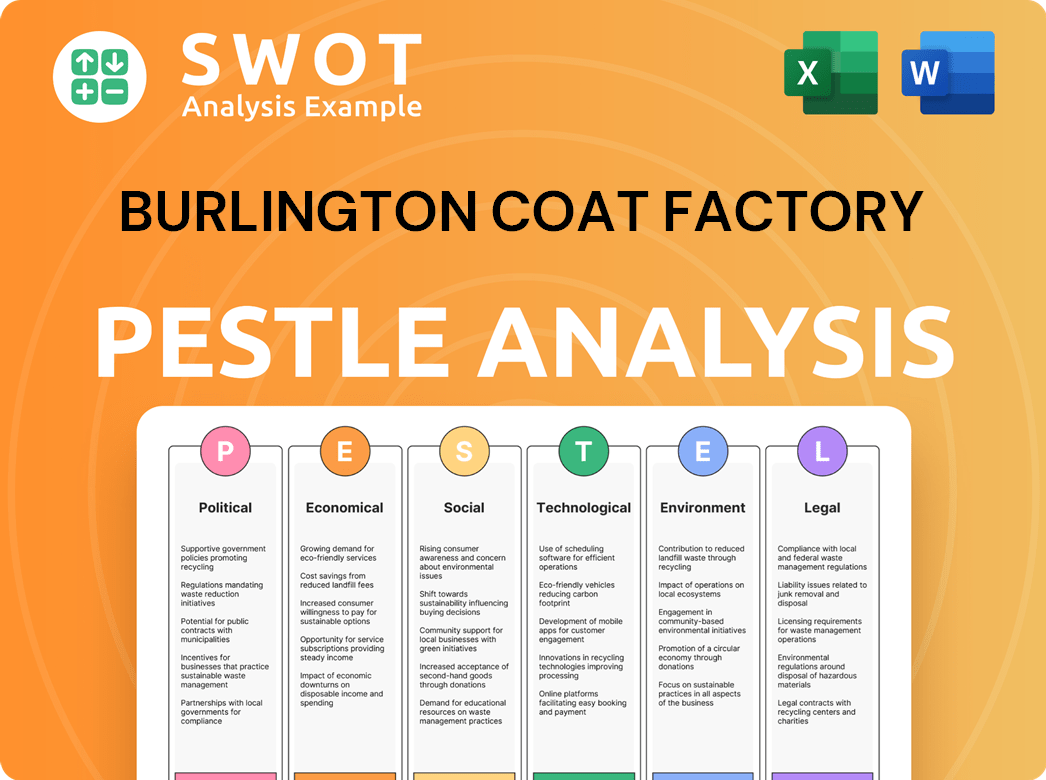
How Is Burlington Coat Factory Positioned in the Market?
Burlington Stores, previously known as Burlington Coat Factory, strategically positions itself as a leading national off-price retailer. This brand positioning centers on offering high-quality, branded merchandise at consistently low prices, a core element of its Burlington Coat Factory sales strategy. The company differentiates itself from traditional department stores by providing significant discounts, often up to 60-70% off, making it a compelling choice for value-conscious shoppers.
The brand's value proposition is consistently reinforced through its visual identity and tone of voice, emphasizing smart shopping and the excitement of finding deals. This 'treasure hunt' shopping experience encourages frequent visits, driving customer engagement and sales. The company's Burlington marketing strategy effectively communicates this value, attracting a broad customer base seeking affordable options for apparel, accessories, home goods, and baby products.
The company's ability to strategically source products and maintain an efficient supply chain is crucial to its competitive advantage and ability to offer attractive prices. This operational efficiency supports its Burlington Coat Factory business model, enabling it to thrive in the off-price retail sector. This focus on value is a key element of its brand positioning.
Burlington's value proposition centers on offering high-quality, branded merchandise at everyday low prices, attracting value-conscious shoppers. This strategy allows the company to compete effectively in the off-price retail market. The emphasis on significant discounts, often up to 60-70% off, is a key differentiator.
The Burlington Coat Factory target market includes individuals and families across various income levels seeking affordable apparel, accessories, home goods, and baby products. The company's broad appeal is supported by its diverse product offerings and strategic pricing. This allows the company to cater to a wide range of consumers.
Burlington's competitive advantage lies in its ability to strategically source products and maintain an efficient supply chain, which enables it to offer compelling prices. This operational efficiency supports its Burlington Coat Factory competitive analysis. This efficiency is crucial for maintaining its market position.
The Burlington Coat Factory pricing strategy is based on offering everyday low prices on branded merchandise, with discounts often reaching 60-70% off. This strategy is a core component of its value proposition and attracts a broad customer base. This approach drives sales and customer loyalty.
The company's 'Burlington 2.0' initiative aims to improve sales, margins, and inventory turnover, further enhancing its competitive position. This includes elevating assortments by increasing the mix of 'better brands,' which reinforces the off-price value proposition. The company's focus on operational efficiency and adaptability helps it respond to competitive threats. For more insights into the company's performance, you can explore the information on Owners & Shareholders of Burlington Coat Factory. Burlington's total revenue reached $10.63 billion in fiscal year 2024, demonstrating its strong market position.
Burlington Coat Factory Business Model Canvas
- Complete 9-Block Business Model Canvas
- Effortlessly Communicate Your Business Strategy
- Investor-Ready BMC Format
- 100% Editable and Customizable
- Clear and Structured Layout
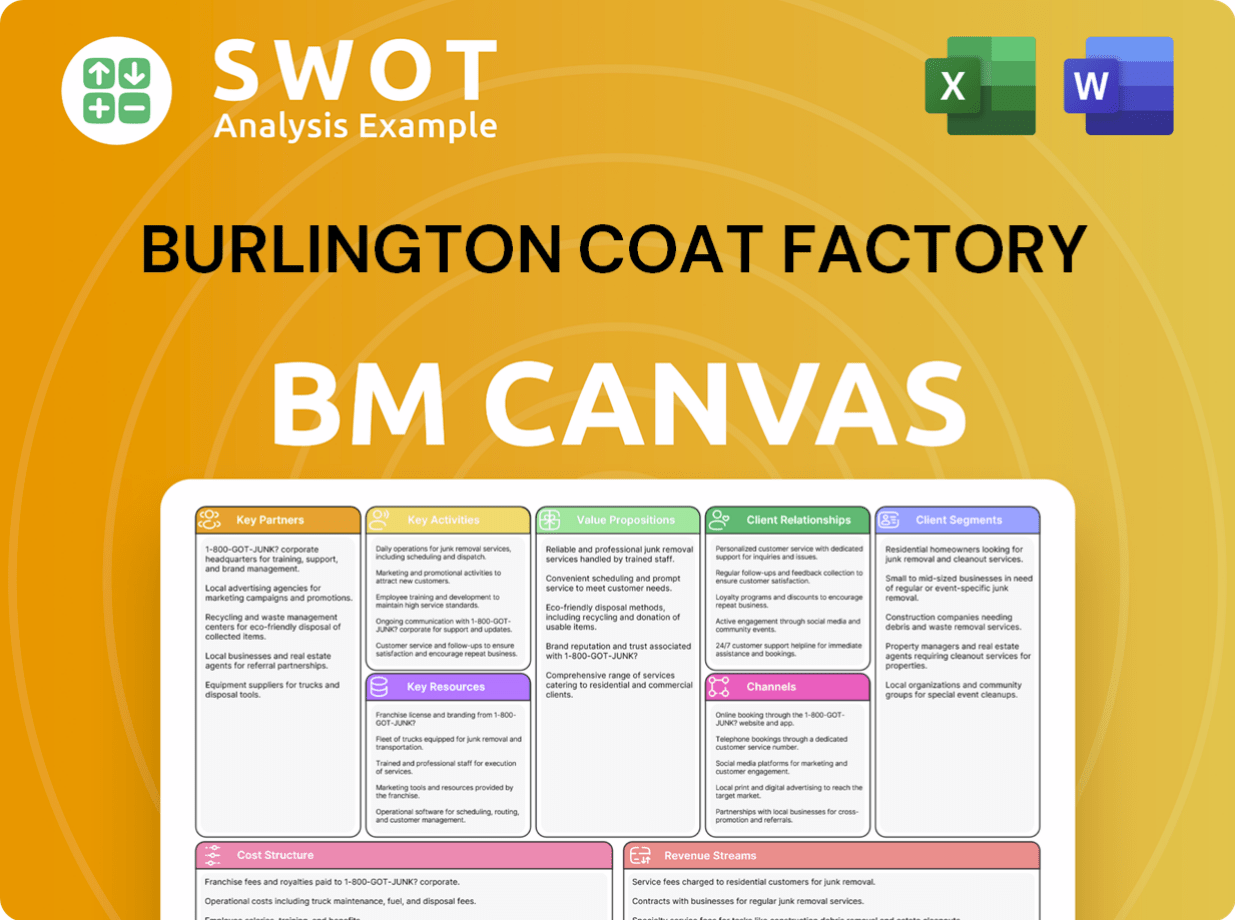
What Are Burlington Coat Factory’s Most Notable Campaigns?
The sales and marketing strategy of the company primarily revolves around offering substantial discounts on branded merchandise. While specific, formally named campaigns with detailed objectives and results for 2024-2025 are not widely publicized, the company's ongoing strategy serves as a continuous campaign. This approach is designed to attract a value-conscious customer base, driving sales through affordability and brand recognition.
The company's sales and marketing efforts are ongoing, with a focus on maintaining its core value proposition: offering significant discounts on branded merchandise. This strategy emphasizes affordability and value, key elements in attracting and retaining customers. The company's advertising and promotional activities consistently highlight these aspects, aiming to drive foot traffic and sales.
The company's consistent emphasis on coats and outerwear remains a significant marketing focus. The company continues to promote itself as a destination for coat shoppers, supported by seasonal promotions and advertising. This strategy leverages its heritage and aims to drive foot traffic during key shopping periods. This focus is a key element of the overall Brief History of Burlington Coat Factory and its ongoing marketing strategy.
Burlington maintains a strong emphasis on coats and outerwear, leveraging its heritage as a destination for coat shoppers. Seasonal promotions and advertising, such as the 'Retro Commercial: Always Been the Place for Coats' TV spot in November 2024, reinforce this brand association. This strategy aims to drive foot traffic during key shopping periods.
The company continuously promotes 'amazing deals' and 'up to 60% off' promotions, especially during holiday seasons. TV spots like 'The Heart of the Holidays: Up to 60% Off' and 'Holidays: Amazing Deals' aired in late 2024, directly communicating the value proposition to consumers. These promotions aim to attract value-conscious shoppers and drive sales.
The 'Burlington 2.0' initiative, launched in fiscal year 2024, functions as an internal campaign aimed at improving sales, margins, and inventory turnover. This initiative has contributed to positive financial results, with total sales increasing 11% and comparable store sales increasing 4% in fiscal year 2024. The company plans to open approximately 100 net new stores in fiscal year 2025.
The success of these initiatives is measured by increased sales, improved operating margins (which expanded by 100 basis points in FY2024), and enhanced profitability. The focus is on driving sales growth and improving operational efficiency through strategic initiatives and expansion.
The company's marketing strategies are designed to attract value-conscious shoppers by emphasizing affordability and brand recognition. These strategies include:
- Continuous promotions highlighting 'amazing deals' and discounts.
- Seasonal advertising campaigns, particularly during holidays.
- Emphasis on coats and outerwear, leveraging the company's heritage.
- Strategic initiatives like 'Burlington 2.0' to drive sales and improve efficiency.
Burlington Coat Factory Porter's Five Forces Analysis
- Covers All 5 Competitive Forces in Detail
- Structured for Consultants, Students, and Founders
- 100% Editable in Microsoft Word & Excel
- Instant Digital Download – Use Immediately
- Compatible with Mac & PC – Fully Unlocked
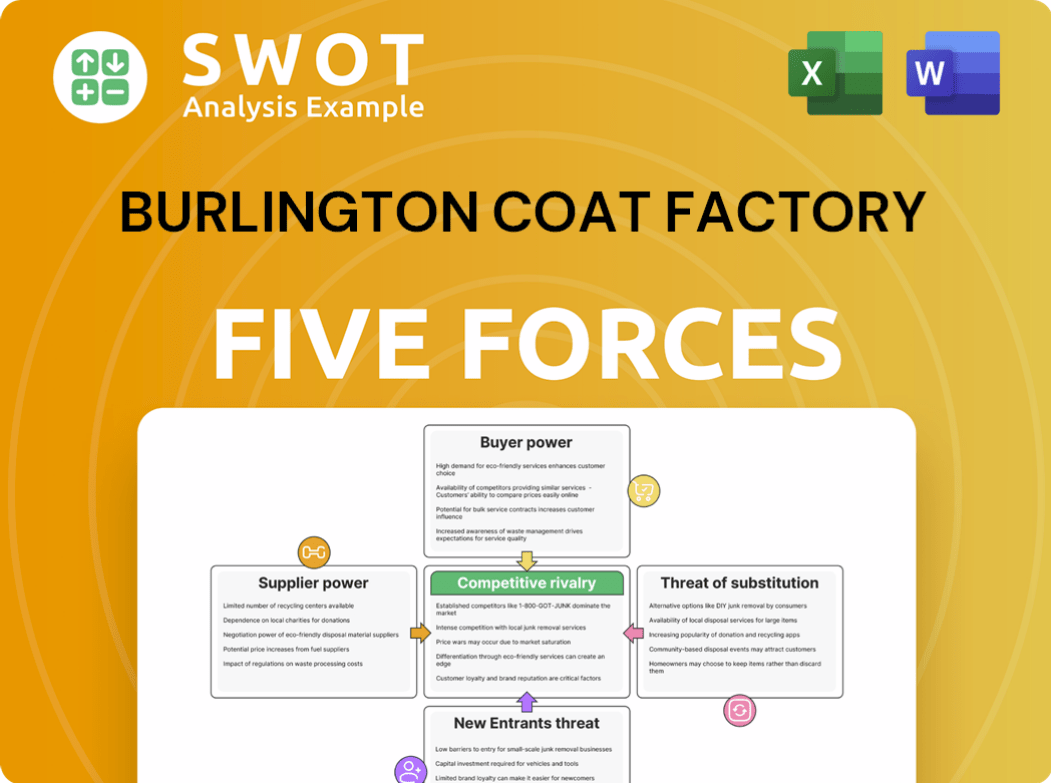
Related Blogs
- What are Mission Vision & Core Values of Burlington Coat Factory Company?
- What is Competitive Landscape of Burlington Coat Factory Company?
- What is Growth Strategy and Future Prospects of Burlington Coat Factory Company?
- How Does Burlington Coat Factory Company Work?
- What is Brief History of Burlington Coat Factory Company?
- Who Owns Burlington Coat Factory Company?
- What is Customer Demographics and Target Market of Burlington Coat Factory Company?
Disclaimer
All information, articles, and product details provided on this website are for general informational and educational purposes only. We do not claim any ownership over, nor do we intend to infringe upon, any trademarks, copyrights, logos, brand names, or other intellectual property mentioned or depicted on this site. Such intellectual property remains the property of its respective owners, and any references here are made solely for identification or informational purposes, without implying any affiliation, endorsement, or partnership.
We make no representations or warranties, express or implied, regarding the accuracy, completeness, or suitability of any content or products presented. Nothing on this website should be construed as legal, tax, investment, financial, medical, or other professional advice. In addition, no part of this site—including articles or product references—constitutes a solicitation, recommendation, endorsement, advertisement, or offer to buy or sell any securities, franchises, or other financial instruments, particularly in jurisdictions where such activity would be unlawful.
All content is of a general nature and may not address the specific circumstances of any individual or entity. It is not a substitute for professional advice or services. Any actions you take based on the information provided here are strictly at your own risk. You accept full responsibility for any decisions or outcomes arising from your use of this website and agree to release us from any liability in connection with your use of, or reliance upon, the content or products found herein.